The VIRRIB sensor is used for stationary measurements of volumetric moisture in the soil environment. The data is in a certain range practically independent of the soil type and its chemical composition. The response of the sensor to changes in humidity is immediate. Also the long-term stability of parameters is better, thanks to the principle of operation and materials used, as their parameters do not change in a humid environment.
The VIRRIB soil moisture sensor is produced in two shape modifications: a circular one with a diameter of 28 cm, and a narrow one, which is approx. 20 cm long and 6cm wide. The measured volume of the substrate reaches in the circular version 15 ÷ 20 l.
The sensor consists of two concentric stainless steel electrodes connected in the sensor body, where the electronic part is placed. The electronic components together with the stainless steel electrodes are mechanically fixed in an embedding compound, which also prevents the penetration of water to the electronics. The sensor cannot be disassembled.
The basic technical parameters:
|
Sensor (order number) |
VIRRIB LP A C |
VIRRIB LP A N |
|
Measuring range (volume in %) |
5 ÷ 50 |
5 ÷ 50 |
|
The shape |
circular, Φ 28 cm |
narrow, 20 x 6 cm |
The VIRRIB sensors are mostly used for direct continuous monitoring of soil moisture at a predetermined station. The sensors should be connected to the modules C-HM-0308, C-HM-1113 or C-HM-1121, see the wiring example.
An FB in the Mosaic environment is available for the measurement, providing proper handling and processing of the measured values. If power is supplied continuously, some electrochemical processes are started, which erode the structure of the measuring electrodes and thereby shorten the lifetime of the sensors. The recommended measuring interval is 15 minutes. Too frequent measurements may shorten the lifetime of the sensor! The connection of the sensors has been worked out in cooperation and as per the documentation[ 11].
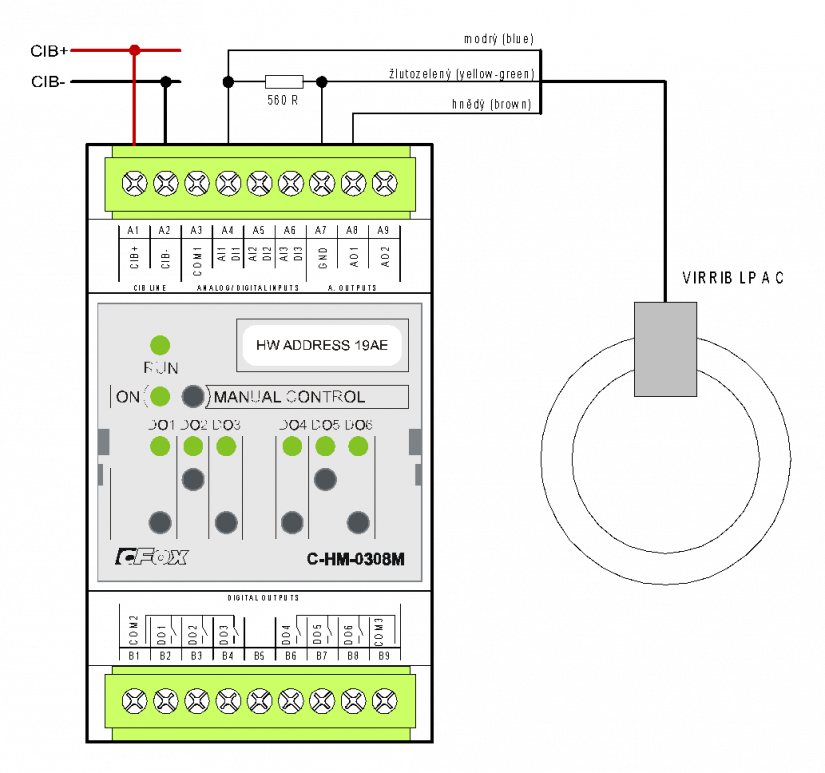
Fig. 1. Wiring the soil moisture sensor to the C-HM-0308M module.
Notes:
-
The standard length of the supply cable is 2m. Other lengths can be supplied based on request.
-
The cable can be extended up to 300m. The recommended cable is, e.g. the J-Y(St)Y 2x2x0.6
-
The sensor can be connected to the AI and AO of the modules C-HM-0308, HM-C-1113 and C-HM-1121, for the wiring see the figure.
-
A 560Ω resistor should be fitted in parallel to the AI module input (a miniature resistor, accuracy is not critical, the load is minimal, 0.1W is sufficient).
-
Principles of the sensor installation are specified in the following text. More detailed materials concerning the usage of these sensors are available on request.
Placement of the sensor
A general principle is that a VIRRIB sensor should be placed in each individually controlled irrigation section. The optimum placement should be selected with respect to typical soils prevalent in the particular property. 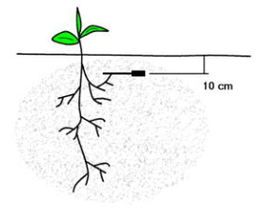
Installation in an area with drip irrigation
If you want to measure the soil moisture and also control drip irrigation, it is recommended to locate the sensor outside the line of the dripping tube and between two drippers. Do not place it directly under the dripper, as there is too much water movement, uncharacteristic for the environment. If the drippers dispense the volume from 2 to 4 litres/hour, the recommended distance is 30cm; at a lower spraying rate it is about 15cm. If the dripping pipe is positioned between two rows of crops, the sensor should be placed in the row below or between plants. In earthy and clayey soils, the diameter of the moistened soil is greater than in sandy soils, it is therefore necessary to take this into account when installing the sensor. The VIRRIB sensor measures the average moisture around its active parts, whether they are positioned vertically or horizontally. In most cases, its range increases by approx. 7cm on each side.
Orientation of the sensor
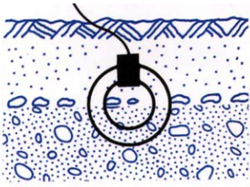
The sensors can be positioned in the soil profile vertically or horizontally; the horizontal placement is in most cases more advantageous. This method allows better filling the space around the active elements of the sensor with soil during the installation, and therefore the measured values reflect the reality better. The layer being measured exceeds the active elements by up to 7cm.
If the sensor is placed in a vertical position, it provides data on the average moisture content in the layer along its active parts. This placement may be suitable when one sensor is used for measuring the moisture in a layer that contains majority of active roots of the plant.
Please note: When the thickness of the layer to be measured is increased, what can happen is that the upper part of the layer is dry and the bottom one is moist. The data from the sensor shows the average humidity in this layer, so it may happen that if the roots are concentrated mostly in the upper part, the crops may still suffer from drought, even though the value of soil moisture is still sufficiently high.
Special care must be taken when the sensor is being covered with soil,
to avoid formation of pockets of air between the soil and the active part of the sensor.
Installation of the sensor.
It is recommended first to place the cable from the sensor horizontally at least 5cm from the sensor, to avoid potential dripping of the irrigation water or rainwater along the cable into the measured area.
Protection of the cable
The cable from the sensor is suitable for being covered with soil or being exposed to the weather. Unfortunately, in nature cables are sometimes damaged by rodents, or during cultivation of crops or other activities. Most problems with sensors are caused by damaged cables. Therefore it is recommended to put on the cable a plastic protection. This protection should be put on the cable as shown in the figure, i.e. first pull it in the horizontal direction, then upward about one meter above the ground, and then turn the tip of the protective plastic downwards. The muzzle should then be bonded with a suitable silicone sealant. The soil around the protective tube should be hardened to prevent infiltration of water into the measurement space, which would distort the measured values.
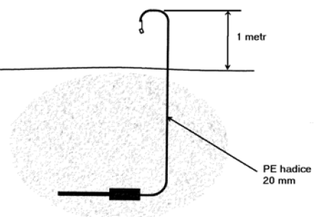
How much water is in the soil (substrate)
Soil is composed of solid particles, the water with dissolved chemicals and
the soil air. Mutual proportions of these three components dynamically change depending
on the water balance, i.e. how fast the water is taken from or put into the relevant
substrate sample. The following figure illustrates types of soil moisture in relation to individual hydrolimits and soil types. When the level of moisture exceeds the field capacity, the pores are filled with water and the soil contains hardly any air. This state is unfavourable for most plants, and the consequences tend to be more tragic than a lack of moisture. In the short term, it can be caused by too extensive irrigation, and the negative effect can be extended if excess water has nowhere to drain. Conversely, if the plants are not watered, the concentration of salt in the rest of the soil water reaches such values, that the suction force of plant roots cannot overcome them and it leads to permanent wilting. The value of soil moisture that corresponds to this state is referred to as the wilting point (WP). The difference between the field capacity and the wilting point is called the soils moisture holding capacity, which serves as a reference point for a reduced availability as a percentage of its value. It is mostly from 50 to 60% of soils moisture holding capacity; in hygrophilous plants it is more, in xerophilousu plants it is less.
The objective of the optimum irrigation control is to maintain soil moisture value in the interval from this point (60% of soils moisture holding capacity) up to the field capacity.
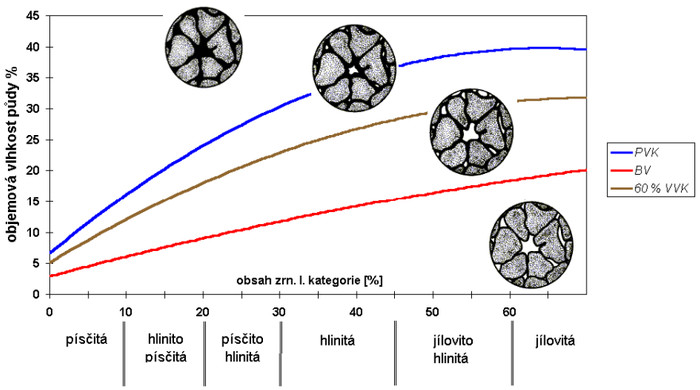
Fig. 2 A diagram of the relation between the soil water volume and the soil type, with displayed hydrolimits.
 English
English